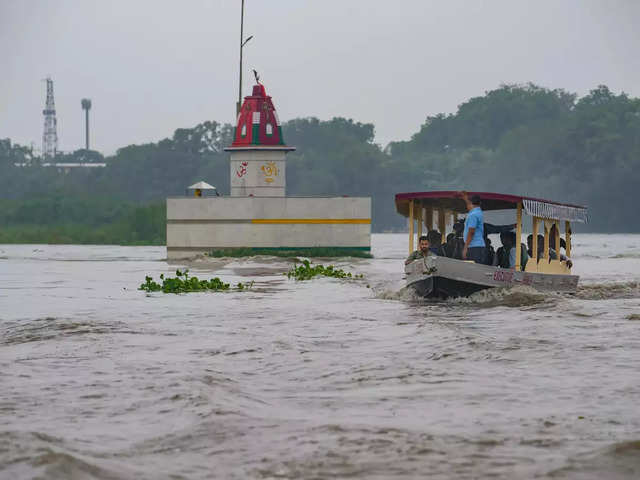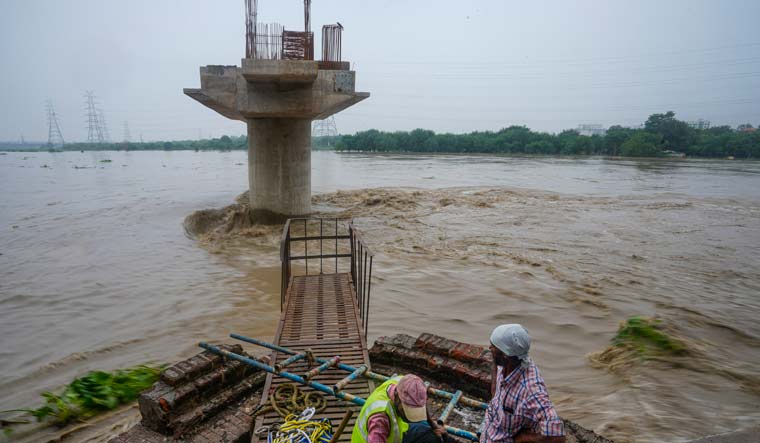Table of Contents
On Wednesday, an unprecedented event unfolded in Delhi as the mighty Yamuna River breached its 45-year water level record. The city found itself grappling with the aftermath of heavy rainfall, which not only resulted in water logging but also severely affected traffic movement in several areas. As the Yamuna River surged to a remarkable height, crossing the 207.49-meter mark, Delhi was put on high alert.

Unprecedented Water Level Surge in Yamuna River
The recent surge in Yamuna’s water level can be attributed to incessant rainfall in the upper catchment areas, encompassing states such as Uttarakhand and Himachal Pradesh, among others. The past few days had witnessed a deluge of rain, saturating the soil and causing the river to swell. The river reached its highest recorded peak of 207.49 meters on September 6, 1978, and had never surpassed that level until now. This extraordinary event highlights the magnitude of the current situation and its historical significance.

Infrastructure Damage and Traffic Advisory in the National Capital
The consequences of the heavy downpour extended beyond the river’s water level. The rainfall wreaked havoc on the city’s infrastructure, causing damage to roads and other vital components. Moreover, the water-logging resulting from the torrential rains further compounded the challenges commuters and residents face. To address this issue, the Delhi traffic police promptly issued an advisory, urging people to avoid affected areas and suggesting alternative routes wherever possible. The objective was to minimize disruptions and facilitate smoother traffic flow despite adverse conditions.

One of the areas heavily impacted by water logging was the Pragati Maidan tunnel, which had to be closed to the public. The closure allowed the authorities to conduct crucial cleaning and maintenance work to ensure the tunnel’s safety and functionality. Delhi Lieutenant Governor VK Saxena had scheduled a visit to the site to personally review the restoration progress, emphasizing the importance of prompt action and efficient recovery efforts.
Restrictions Imposed for Repair Work on C-Hexagon Stretch
In addition to the water logging, another area of concern was the C-Hexagon stretch near India Gate, specifically the segment near Sher Shah Road. Here, a road collapse occurred, necessitating immediate repair work. To facilitate the repairs, traffic movement in the affected area had to be restricted. The Delhi police promptly disseminated information about the restrictions and advised commuters to plan their journeys accordingly, considering the potential delays and detours.

In light of the dangerously high water level in the Yamuna River, the authorities took proactive measures to ensure public safety. The Iron Bridge Pusta Road in Gandhi Nagar was temporarily closed to the public and vehicular traffic until further notice. This decision was made to prevent any accidents or mishaps that could arise from the heightened water level and the potential risks associated with it.
Understanding the potential risks and impact of the flooding, the Delhi government established 16 control rooms to closely monitor the situation. These control rooms served as command centers, gathering real-time data on the water level and flood-prone areas. With approximately 41,000 residents living in low-lying regions vulnerable to flooding, it was imperative to maintain constant vigilance and take appropriate actions to mitigate risks and ensure the safety of the affected communities.
Burst Water Pipeline Causes Water-Logging on Najafgarh Road
Furthermore, the heavy rainfall also disrupted Najafgarh Road, specifically on the carriageway from Zakhira to Moti Nagar. A burst water pipeline resulted in water logging on the road, exacerbating the traffic woes in the area. Authorities urged commuters to avoid the affected stretch and seek alternative routes to minimize inconvenience and potential hazards.
As the situation unfolded, it became crucial for residents and commuters in Delhi to stay informed and exercise caution. Following the advisories issued by the authorities and staying updated with live updates from credible sources would be instrumental in ensuring personal safety and minimizing any inconveniences caused by the flooding and traffic disruptions.
Delhi on High Alert as Yamuna River Breaks 45-Year Record
In conclusion, Delhi faced a critical situation as the Yamuna River breached its 45-year water level record due to incessant rainfall. The resulting water-logging and traffic disruptions posed significant challenges for the city and its residents. Prompt actions, such as issuing advisories, implementing traffic restrictions, and establishing control rooms, were undertaken to manage the situation effectively and ensure public safety. Vigilance, awareness, and cooperation from the public were crucial in navigating through these extraordinary circumstances and minimizing any adverse impacts.

Refer here: Delhi on high alert as Yamuna water level breaches 45-year record; traffic advisory issued














